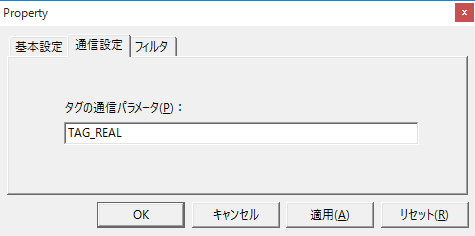About the connection example
Please see below for an example of connection settings for this driver.
Applicable models etc. |
explanation |
This is an example of connection settings with the Allen Bradley Logix-5550 series.
|
*For connections with other compatible models, please refer to the above for setup.
Device List
The compatible devices are as follows (see here for how to view the device list).
Data Type |
Read max |
Write max |
|
Bit |
BOOLEAN |
1 |
1 |
Bit array (32bit) |
BOOLEAN ARRAY(32bit chunks) |
123 (123*32=3936bit) |
58 (58*32=1856bit) |
8 bit integer |
SINT |
1 |
1 |
8 bit integer array |
SINT ARRAY |
492 |
232 |
16 bit integer |
INT |
1 |
1 |
16 bit integer array |
INT ARRAY |
246 |
116 |
32 bit integer |
DINT |
1 |
1 |
32 bit integer array |
DINT ARRAY |
123 |
58 |
32 bit float |
REAL |
1 |
1 |
32 bit float array |
REAL ARRAY |
123 |
58 |
String |
STRING |
1 |
1 |
String array |
STRING ARRAY |
5 |
2 |
About tag settings
Unlike PLCs from Mitsubishi, Omron, etc., Allen-Bradley PLCs use a tag-based address system. To set it up, just set the tag name on the Allen-Bradley PLC side, as shown in the tag property dialog below.

Item names can be specified according to the following rules:
TAG name (.size) (.data type) TAG name[x] (.size) (.datatype) TAG name [x,y] (.size) (.data type) TAG name [x,y,z] (.size) (.data type) |
The maximum size is limited to the number specified by Read Max( for read-only tags) / Write Max( for read/write tags) in the table above.
For example, if the REAL type tag "DATA[1][2][3]" is set in the PLC, you can directly specify the elements of the array by specifying "DATA[1,0,0]" as the item name in the dialog shown above (using only "DATA" will result in communication with "DATA[0,0,0]").
You can also treat it as an array by adding a size to the end. For example, "DATA.100" will treat 100 pieces of data from "DATA[0,0,0]" as an array. Similarly, "DATA[1,2,0].100" will be an array of 100 tags from DATA[1][2][0].
however,The maximum size is the number specified by Read Max/WriteMax in the table above.It will be.
Also, for Bit type arrays, they are treated as 32-bit integers. In other words, one size is 32 bits. Bits are packed in order from 0th bit to 31st bit.
Additionally, the data type can be omitted. If omitted, the tag's data type will be automatically obtained and processed internally during initial communication. However, if there are a large number of tags, communication to obtain data types at the start of communication will occur for each tag, which may slow down the first communication. In that case, by specifying the data type for each tag, communication to obtain data types will not occur, allowing communication to start smoothly.
The data type can be specified asBOOLEAN / SINT / INT / DINT / REAL / STRINGis.
example)
// Same as TAG01..INT // If the data size is 1, the 1 between the dots can be omitted. TAG02..DINT TAG03.[10].5.STRING |
Also, if the tag name contains a dot ".", enclose the tag name in single quotation marks.
example)
Example 1) 'ABC.DEF' // The tag name contains a "." so it is enclosed in single quotes. Example 2) 'ABC.DEF'[1].2 // Arrays and sizes should be specified after single quotation marks. |
|
The ControlLogix communications driver queries PLC for communications using the PLC tag name string, so the longer the tag name string, the less data can be communicated in one packet. The shorter the PLC tag name, the faster the communication will be. For example, when defining 1,000 tags, communication will be faster from "T[0]..INT" to "T[999]..INT" than from "TAG_ABC_EFG[0]..INT" to "TAG_ABC_EFG_[999]..INT". |